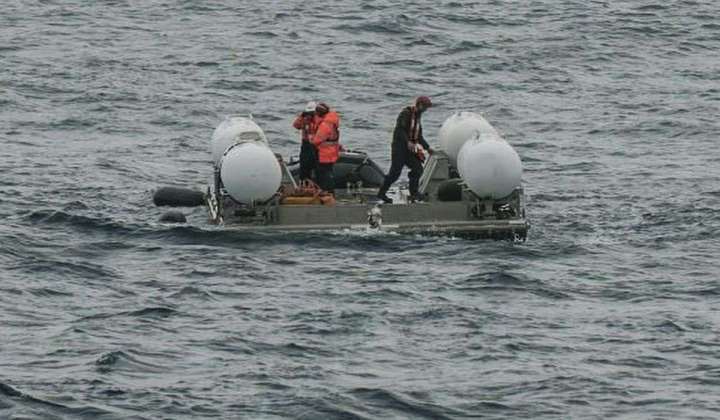Race is on to find missing sub near Titanic as vessel’s oxygen supply dwindles

The search for a small submarine that disappeared with five crew members aboard in the North Atlantic, near the deep-sea wreckage of the Titanic, reached an urgent stage Tuesday as the vessel’s oxygen supply dwindled.
U.S. Coast Guard Capt. Jamie Frederick said during an afternoon media briefing in Boston that the Titan, a 21-foot tourism and research submersible, had about 41 hours of breathable air remaining — less than half of the vessel’s initial 96-hour supply.
Some analysts familiar with the craft and its previous journeys to the Titanic’s final resting place 2.5 miles below the surface pointed out that concerns about the oxygen supply may be moot. The crew is likely to freeze to death in the depths of the North Atlantic before rescuers arrive, they said.
The firm that operates the submersible lost contact with the crew on Sunday.
Coast Guard officials said they don’t have any in-house equipment to venture 2.5 miles below the surface to the Titanic site. They said they were in discussions with private companies with the technology to aid in the search.
Authorities didn’t disclose whether those private companies were already on the scene. The U.S. Coast Guard, the Canadian Coast Guard and the Canadian Armed Forces are coordinating the search.
“This is a very complex search, and the unified team is working around the clock to bring all available assets and expertise to bear as quickly as possible in an effort to solve this very complex problem,” Capt. Frederick said.
French President Emmanuel Macron is sending the research ship Atlante to join the search for the small submarine. The Atlante, which should arrive at the search area by Wednesday night, has a robot that can reach the depths of the Titanic’s wreckage.
“This is a race of time that started [Monday] night, and France has responded to the calls from American authorities,” Herve Berville, France’s secretary of state in charge of sea, told CNN affiliate BFMTV on Tuesday.
The search covers an area slightly larger than Connecticut and consists mainly of authorities deploying sonar buoys on the surface that can detect sounds underwater.
Capt. Frederick said search teams are also using remotely operated vehicles that can go beneath the surface to look for clues about the submersible’s whereabouts.
Excursion organizer OceanGate Expeditions first reported the Titan missing Sunday night. The Coast Guard said the company lost contact with the vessel less than two hours after its descent Sunday morning.
Aboard the Titan are OceanGate’s founder and CEO, Stockton Rush, British explorer Hamish Harding, Titanic researcher Paul-Henri Nargeolet and British businessman Shahzada Dawood and his son, Suleman.
CBS News reporter David Pogue, who rode in the Titan for a report last year, said hope is “quickly fading” for the missing crew.
He said the vessel has a fail-safe mechanism that allows it to float to the surface without power.
If that isn’t the case, Mr. Pogue told CBS, that “could only mean two things: Either they got snagged on something on the bottom of the sea, which is pretty unlikely. There’s nothing there but the Titanic. Or there was a breach in the hull and it instantly imploded.”
The journalist pointed out that no safety regulators tested other features on the Titan, such as its 96-hour air supply. The operators conduct meticulous safety checks, but some of the Titan’s construction is improvised because the machine is novel.
Mr. Pogue told the network that it’s “really bad” that the Titan lost its signal during its descent. To him, that meant that something “catastrophic” took place.
Even if the crew is alive and stuck on the seabed, concerns remain.
An interview with Mr. Nargeolet that aired in 2017 said crew members could survive four to five days but would likely freeze to death first.
“The real problem at [the Titanic’s] depth is the temperature because the water temperature is 33 degrees,” the former diver for the French navy said. “After a while, you die because of the cold, which is not a bad way to die because you fall asleep and you don’t suffer.”
Mr. Pogue told CBS that the deepest submarine rescue ever performed was 1,500 feet. The Titanic’s wreckage sits at 13,000 feet.
“There’s no other craft that can get down there in time,” Mr. Pogue said.






